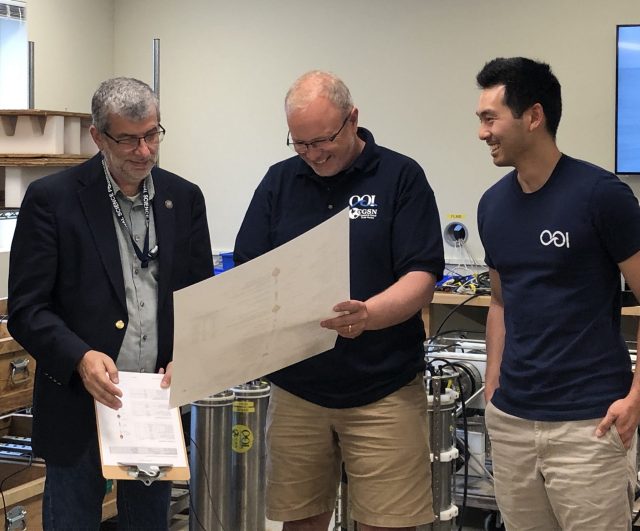Posts Tagged ‘Large Facilities Office’
NSF Large Facilities Team Visits OOI at WHOI
Representatives from the National Science Foundation’s (NSF) Large Facilities Office visited Woods Hole Oceanographic Institution (WHOI) on Monday June 26-Tuesday June 27 to get a first-hand look at the various facilities at WHOI supported by the NSF. The visit kicked off at LOSOS on the Quissett Campus with a discussion of the Ocean Observatories Initiative (OOI), followed by a tour of its facilities.
OOI’s program office (PMO) is located at WHOI and led by Principle Investigator Jim Edson. On Monday morning, Edson welcomed the NSF visitors, introduced the PMO team, and provided an overview of OOI’s organization, operations, and how scientists are using its data to expand understanding of ocean processes and conditions. OOI Senior Program Manager Paul Matthias followed with a technical presentation of how this large and complex program is managed, kept on budget with continuous collection and disseminating of OOI data.
[media-caption path="https://oceanobservatories.org/wp-content/uploads/2023/06/IMG_1148-2-scaled.jpg" link="#"]WHOI Assistant Scientist Hilde Oliver gave a lightning talk on how she used OOI data to explain the role of wind in ephemeral surface chlorophyll enhancement at the New England Shelf Break. [/media-caption]A Q&A session was held over lunch. The afternoon session commenced with virtual presentations by the OOI Data Center at Oregon State University, followed by a review of major components, organization, and operations of three OOI components – Coastal Endurance Array at Oregon State University, Coastal and Global Scale Nodes at WHOI, and the Regional Cabled Array at the University of Washington. A tour of LOSOS followed the presentations.
[media-caption path="https://oceanobservatories.org/wp-content/uploads/2023/06/IMG_1163-scaled.jpg" link="#"]OOI Instrumentation Lead Jennifer Batryn took apart an Acoustic Doppler Current Profiler (ADCP) during a tour of the LOSOS electronics lab during an NSF visit. [/media-caption]The NSF visitors attending the daylong session focused on OOI were Linnea Avallone, Chief Officer for NSF Research Facilities, Jim McManus, Director Division of Ocean Sciences, and George Voulgaris, OOI Program Manager. Rose Dufour, Program Director Ship Operations, joined the group for a tour of the OOI facilities in LOSOS.
“We were delighted to have the opportunity to show off the technically advanced and rugged OOI ocean observing equipment and the amazing talents of the team who designs, builds, maintains, and keeps this equipment operating in difficult conditions to our NSF colleagues,” said Jim Edson, Lead PI of OOI’s Program Office. “Seeing the size and scope of the equipment firsthand gives one a real understanding of the complexity of OOI operations and the importance of the data being collected and integrated into research.”
The NSF visitors returned to WHOI on Tuesday morning to visit and learn more about other NSF-sponsored programs at WHOI, including a visit to the National Deep Submergence Facility, ship operations, the Northeast U.S. Shelf (NES) Long-Term Ecological Research (LTER) project, and the Center for Chemical Currencies of a Microbial Planet.
OOI Program Director George Voulgaris spent the second day of his visit to WHOI with members of OOI’s Program Office and the Coastal and Global Scale Nodes (CGSN) team. On Tuesday, CGSN members showed off their northern LOSOS facility, where they were burning in equipment for deployment at the Global Irminger Sea Array this summer and testing two Autonomous Underwater Vehicles (AUV) prior to deployment. The visit ended with a pizza lunch that provided Voulgaris an opportunity to meet all members of the CGSN team and learn more about their individual roles and responsibilities.
[media-caption path="https://oceanobservatories.org/wp-content/uploads/2023/06/IMG_1168-scaled.jpg" link="#"]George Voulgaris, OOI Program Manager (left) discusses mooring issues with OOI Senior Program Manager Paul Matthias, and OOI Lead Jim Edson during a tour of the LOSOS outdoor facility, where segments of OOI moorings are stored prior to mobilization. [/media-caption] [media-caption path="https://oceanobservatories.org/wp-content/uploads/2023/06/IMG_1172-scaled.jpg" link="#"]OOI Coastal and Global Scale Nodes Project Manager Derek Buffitt explains the components that comprise the Multi-Function Node, which holds the anchor and instrumentation near the bottom of the OOI arrays, to Linnea Avallone, Chief Officer for NSF Research Facilities during a tour of OOI LOSOS. [/media-caption] [media-caption path="https://oceanobservatories.org/wp-content/uploads/2023/06/IMG_1197-scaled.jpg" link="#"]OOI Glider Lead Peter Brickley explains the operation of the tail fin and air bladder of an OOI glider to NSF OOI Program Director George Voulgaris. [/media-caption] [media-caption path="https://oceanobservatories.org/wp-content/uploads/2023/06/IMG_1226-scaled.jpg" link="#"]NSF OOI Program Director George Voulgaris (left) reviews the components of a global surface mooring with OOI Senior Engineer John Lund and Research Engineer James Kuo. [/media-caption] [media-caption path="https://oceanobservatories.org/wp-content/uploads/2023/06/IMG_1235-scaled.jpg" link="#"]Glider Lead Peter Brickley explains the operations of the Autonomous Underwater Vehicle (AUV), REMUS to NSF OOI Program Director George Voulgaris. Diana Wickman, left rear, who keeps the AUVs operational was on hand for the presentation and to answer questions about the vehicle’s operations, as well. [/media-caption]Photos taken by Darlene Trew Crist © WHOI.
Read More

